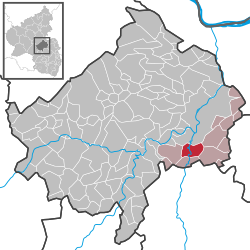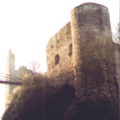|
Altenbamberg
Altenbamberg is an Ortsgemeinde – a municipality belonging to a Verbandsgemeinde, a kind of collective municipality – in the Bad Kreuznach district in Rhineland-Palatinate, Germany. It belongs to the Verbandsgemeinde of Bad Kreuznach, whose seat is in the like-named town. GeographyLocationThe recreational village of Altenbamberg lies in the Alsenz valley on the edge of the North Palatine Uplands at an elevation of 130 m above sea level. The municipal area measures 753 ha, of which 286.5 ha is wooded, 50 ha is used for winegrowing (vineyards) and 226 ha is used for agriculture.[3] Neighbouring municipalitiesAltenbamberg borders in the north on the town of Bad Münster am Stein-Ebernburg, in the northeast on the town of Bad Kreuznach, in the east on the municipalities of Frei-Laubersheim and Fürfeld, in the south on the municipality of Hochstätten and in the west on the municipality of Feilbingert. HistoryThe narrow stretch of the Alsenz valley where Altenbamberg now lies is known to have been settled even in prehistoric times. The Stone Age archaeological finds from the Altenbamberg and Neu-Bamberg area have yielded clues as to a settlement here in the New Stone Age. Traces of Bronze Age dwellings have been confirmed in this same area and also near Frei-Laubersheim and Siefersheim (the latter in the neighbouring Alzey-Worms district). It may be assumed that Bronze Age dwellings were represented in the North Palatine-Rhenish-Hessian region rather densely. In 1903, near the Schäferplacken (a wooded area) within Altenbamberg's limits, an archaeological dig at the Hünengräber ("Huns' Graves" – actually barrows) was undertaken with great eagerness. Recovered from this operation were grave goods that were most important to confirming the presence of an Iron Age culture in the area from about 750 to 15 BC.[4] Right from the beginning, Altenbamberg's history has been bound to the castle, Altenbaumburg. This castle, which had its first documentary mention in 1129, was seat to the line of the Raugraves, descendants of the Emichones, who from 960 were counts in the Nahegau. The village's name has nothing to do with the Franconian town of Bamberg, but rather derives from the castle's name. Other names that the village has borne over the ages are as follows:
In 1798, as a result of administrative restructuring in the wake of the French Revolution, Altenbamberg found itself in the Department of Mont-Tonnerre (or Donnersberg in German).[4] After the Congress of Vienna, Altenbamberg passed to the Kingdom of Bavaria where it became part of the Rheinkreis, as the kingdom called the Palatinate, which was now a Bavarian exclave. The village remained with Bavaria until the end of the Second World War. In the course of administrative restructuring in Rhineland-Palatinate, Altenbamberg was transferred in 1969 from the Rockenhausen district (which itself was dissolved) to the Bad Kreuznach district, in which it remains today. With regard to ecclesiastical organization, Altenbamberg belongs as before to the Evangelical Church of the Palatinate and the Roman Catholic Diocese of Speyer. Population developmentThe table shows Altenbamberg's population development. The figures in the table from 1871 to 1987 are based on censuses:[5]
ReligionAs at 31 August 2013, there are 739 full-time residents in Altenbamberg, and of those, 346 are Evangelical (46.82%), 203 are Catholic (27.47%), 1 is Russian Orthodox (0.135%), 1 is Lutheran (0.135%), 26 (3.518%) belong to other religious groups and 162 (21.922%) either have no religion or will not reveal their religious affiliation.[6] PoliticsMunicipal council
The council is made up of 12 council members, who were elected by majority vote at the municipal election held on 7 June 2009, and the honorary mayor as chairman.[7] MayorAltenbamberg's mayor is Holger Markus Conrad, elected in 2019.[1] Coat of armsThe municipality's arms might be described thus: Argent in base ground with a mount in the middle vert upon which and to each side a tree of the same, under the trees a bar wavy of the field and in chief, each side of the middle tree two mullets Or. The arms violate a traditional rule of heraldry by placing a metal upon another metal (the gold mullets on the silver field). Culture and sightseeing BuildingsThe following are listed buildings or sites in Rhineland-Palatinate's Directory of Cultural Monuments:[8]
Regular eventsMany visitors from near and far come each year to the Burgfest ("Castle Festival") to celebrate in a special atmosphere and enjoy the Altenbamberg wine.[10] Sport and leisureOuting destinations are the Altenbaumburg, the Treuenfels (both castle ruins), the Schäferplacken and the Rödelstein. There is an outstanding hiking trail network with a grilling facility and a shelter in wooded surroundings.[11] Economy and infrastructureTransportLeading through Altenbamberg is Bundesstraße 48. Serving the village is a railway station on the Alsenz Valley Railway (Alsenztalbahn). Economic structureAltenbamberg lies in the Nahe wine region, and still has one full-time winemaker. For the villagers, there are a supermarket and a bakery. Medical services are being taken over mainly by the bordering towns of Bad Münster am Stein-Ebernburg and Bad Kreuznach. There are also "gastronomical" establishments with ten beds.[12] ChurchesAltenbamberg also has one Evangelical church and one Catholic church, each with weekly services. References
External linksWikimedia Commons has media related to Altenbamberg. |
||||||||||||||||||||||||||||||||||||||||||||||||||||||||||||||||||||||||||
Portal di Ensiklopedia Dunia







